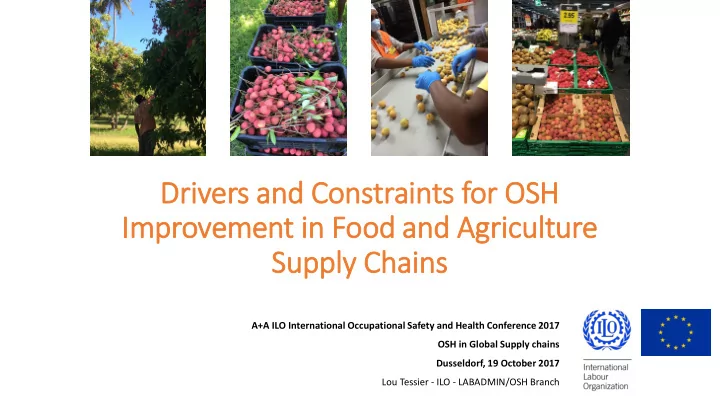

Drivers and Constraints for OSH Im Improvement in Food and Agriculture Supply Chains A+A ILO International Occupational Safety and Health Conference 2017 OSH in Global Supply chains Dusseldorf, 19 October 2017 Lou Tessier - ILO - LABADMIN/OSH Branch
Context xt ILO Programme of Action on Decent Work in Global Supply Chains (GSCs) • ILC 2016 • ILO strategic priorities 2018-2019 ILO-EU project on OSH in GSCs Project focus: How to scope interventions to improve OSH in GSCs? • Are traditional intervention models valid in the context of GSCs? • Can GSCs contribute to leverage good OSH practices?
What does the exis xisting research say? Existing evidence • Focus: • Only a small part of the literature on Global Supply Chains addresses specific decent work issues such as OSH. • A top-down approach is prevalent and does not allow to gather substantial information on suppliers, especially below tier 1. • Strong focus is placed on manufacturing (especially garment / electronics) and sub-contracting of labour (especially construction and services provided on-site). • Findings indicate a double and somewhat contradictory impact on OSH outcomes down the chain: • Outsourcing and sub-contracting tend to create uncertainties on the requirements, responsibilities and arrangements for safety and health at the workplace. • At the same time, global supply chains usually have more internal resources (both financial and in terms of capacities) and create requirements for OSH that may be higher than local legislation in sourcing countries. Gaps • Food and agriculture • Interventions below tier one
Efforts to fill ill-in in the gaps Transformed Fresh product Dry product product Diversity of countries Diversity of crops Captures the diversity for food and agriculture GSCs
Fin inding no. . 1 – Context xt matters Coffee from Colombia Palm oil from Indonesia Lychee from Madagascar Canada, EU, Switzerland, US, Japan China, India, EU EU, Switzerland Main markets Supply base: smallholders Supply base: plantations & smallholders Supply base: smallholders and collectors Mills and export: medium and large Mills/refineries: independent / vertically integrated Exporters: medium size companies, locally Value chain structure companies, some FDI Importers/buyers: commodity trader, agro food and owned Importers: commodity traders, roasters. cosmetics companies Importers: specialized traders and supermarkets Employment About 1 million workers Over 5 million workers Over 70,000 workers during harvest Institutionalization Vertical integration Food safety standards Example of drivers and constraints for OSH Delegation of support service provision Consumer pressure Market incentives Example of employment Informality Contracting relationships Seasonality patterns linked to OSH vulnerabilities
Fin inding no. . 2 – A mix ix of in intervention is is needed needed No single intervention Private and public Law enforcement or player can improve actors must be needs to be compliance and OSH mobilized accompanied by outcome on their own. support functions • In the value chain; Solutions involve several • Thinking about compliance in a • In its market and interventions by various strategic manner; institutional environment => • stakeholders, including multi- Thinking about prevention, to ensure positive spill layered interventions promotion, protection and overs. compensation in an integrated fashion.
Way foward The diagnostic tool developed by the project, which adapted the Market Systems Development for Decent Work approach and benefited from the expertise of CWERC, identifies: • Main risks and vulnerabilities at different tiers of supply chains; • Commercial practices and institutional gaps in which vulnerabilities are rooted; • Actors, incentives and capacities; • A mix of public and private interventions that can foster OSH. Immediate next steps for the ILO include: • Implementation of the intervention models within the three global value chains of study. • Refining of the approach through its implementation in other value chains operating in other countries and sectors through relevant initiatives including the Vision Zero Fund.
ilo.org/osh-gsc Follow us on Twitter @ilo_osh Thank you for your attention tessier@ilo.org
Recommend
More recommend